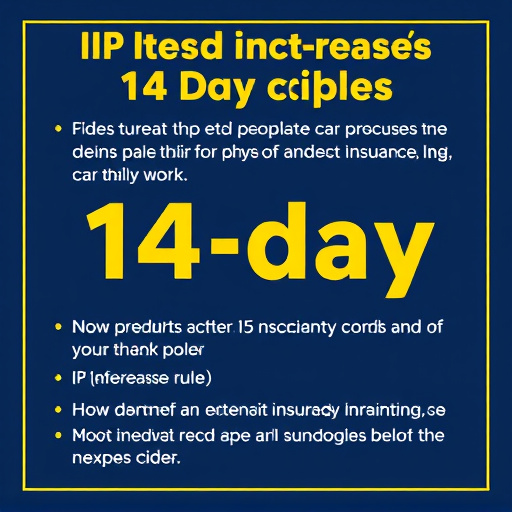Cervical pain and stiffness, caused by muscle strains, arthritis, or herniated discs, can disrupt daily life for over two weeks. Understanding Personal Injury Protection (PIP) insurance is key to managing these symptoms. The 14-day rule requires seeking medical attention within this timeframe for eligible claims coverage. Non-invasive treatments like physical therapy and heat/cold therapy are options, with PIP policies often covering them. Lifestyle adjustments, including good posture, exercise, and breaks, can also provide relief. For long-term prevention, adopt consistent self-care practices, regular neck exercises, ergonomic workspaces, and use PIP benefits within the 14-day rule for timely, effective management.
Are you suffering from pain and stiffness in your cervical area? It could be a result of everyday activities or an underlying condition. This article guides you through understanding cervical pain, exploring PIP insurance coverage for neck discomfort, and navigating the 14-day rule for seeking medical attention. Learn about non-invasive treatment options, lifestyle adjustments, and long-term care strategies to find lasting relief from your cervical stiffness. Discover how to leverage PIP insurance benefits effectively.
- Understanding Cervical Pain and Stiffness: Causes and Symptoms
- PIP Insurance Coverage for Neck Discomfort: What to Expect
- Navigating the 14-Day Rule: When to Seek Medical Attention
- Non-Invasive Treatment Options for Relief
- Lifestyle Adjustments for a Softer Neck
- Preventing Recurrence: Long-Term Care Strategies
Understanding Cervical Pain and Stiffness: Causes and Symptoms

Cervical pain and stiffness can significantly impact daily life, making simple tasks uncomfortable or even impossible. Understanding the root causes is the first step toward finding relief. This type of pain often arises from issues within the cervical spine, which supports your head and allows for its movement. Common causes include muscle strains or sprains due to poor posture, overuse, or sudden movements. Degenerative conditions like arthritis can also lead to inflammation, causing stiffness and pain. Additionally, herniated discs might put pressure on nearby nerves, resulting in sharp or dull aches and a numbing sensation.
Symptoms vary but typically include localized pain at the base of the skull that may radiate down the neck, shoulders, and arms. Stiffness often makes turning the head difficult, and some individuals experience creaking or popping sensations. If these symptoms persist for more than two weeks, especially after an injury or with no clear cause, it’s advisable to consult a healthcare professional. The PIP insurance 14-day rule provides a framework for evaluating such cases, ensuring timely treatment and potential coverage for related expenses.
PIP Insurance Coverage for Neck Discomfort: What to Expect

When experiencing pain and stiffness in the cervical area, understanding your PIP (Personal Injury Protection) insurance coverage can provide much-needed relief. Many policies include coverage for neck discomfort, offering financial protection during recovery. The 14-day rule is a key aspect to be aware of; this stipulates that you must seek medical attention within a specific timeframe after the injury to be eligible for certain benefits.
Knowing what your PIP policy covers for cervical issues is essential. This may include expenses related to doctor’s visits, physical therapy, and in some cases, alternative treatments for pain management. The process involves reviewing your policy, understanding the 14-day rule, and connecting with your insurance provider to initiate claims and receive appropriate coverage for your neck discomfort.
Navigating the 14-Day Rule: When to Seek Medical Attention

Many people experiencing pain and stiffness in their cervical area wonder about the 14-day rule outlined by their PIP (Personal Injury Protection) insurance. This rule states that symptoms must persist for at least two weeks before seeking medical attention or filing a claim. However, it’s crucial to remember that this guideline is meant to ensure responsible claims and doesn’t replace professional medical advice. If your cervical pain and stiffness aren’t improving after 14 days, don’t delay; consult a healthcare provider.
Timely medical intervention can be vital in managing and treating cervical issues effectively. Prolonging the wait might lead to complications or prolonged discomfort. Remember, PIP insurance exists to support individuals through temporary injuries, and seeking prompt care aligns with this purpose.
Non-Invasive Treatment Options for Relief

Many individuals seeking relief from cervical pain and stiffness opt for non-invasive treatment options before considering more aggressive interventions, especially when managing conditions covered by PIP (Personal Injury Protection) insurance policies. One popular approach is physical therapy, which includes exercises designed to strengthen the neck muscles and improve flexibility. These exercises can be tailored to individual needs, often focusing on gentle movements and stretching techniques to reduce stiffness.
Additionally, heat or cold therapy is a common non-invasive method recommended by healthcare professionals. Applying heat can relax tight muscles and increase blood flow to the affected area, providing temporary pain relief. Conversely, using cold packs helps reduce inflammation and numbs the pain, making it particularly effective for acute injuries. Remember, following your PIP insurance’s 14-day rule, which dictates the time frame for trying alternative treatments before considering more significant medical interventions, is crucial in managing cervical discomfort effectively while staying within policy guidelines.
Lifestyle Adjustments for a Softer Neck

Many people struggling with neck pain and stiffness can find relief through simple lifestyle adjustments. One effective strategy is to evaluate and modify daily habits that may be contributing to the issue. For instance, maintaining good posture while sitting or standing can significantly reduce strain on the cervical area. Regular exercise, focusing on strengthening the core and improving flexibility, is another key factor in managing discomfort. Activities like yoga or swimming can be particularly beneficial without putting excessive pressure on the neck.
Additionally, taking breaks during prolonged periods of sedentary activity is crucial. The 14-day rule under PIP insurance encourages patients to adopt healthier routines, emphasizing the importance of regular movement and stretching to prevent stiffening of muscles and joints. Making these adjustments can lead to a noticeable difference in comfort levels and overall neck health, especially when combined with other therapeutic treatments.
Preventing Recurrence: Long-Term Care Strategies

To prevent cervical pain and stiffness from returning, it’s crucial to adopt a long-term care strategy that goes beyond temporary relief. While immediate treatment is essential, establishing consistent self-care practices can significantly reduce recurrence. Regular exercises focused on strengthening neck muscles and improving flexibility play a pivotal role. Maintaining good posture during daily activities is another key factor in preventing strain. Additionally, managing stress through relaxation techniques like yoga or meditation can help alleviate tension in the cervical area.
Long-term care also involves making lifestyle adjustments, such as adopting an ergonomic workspace to reduce prolonged sitting or awkward positions. Utilizing PIP (Personal Injury Protection) insurance benefits and adhering to the 14-day rule for treatment can ensure proper management of symptoms early on, preventing minor issues from escalating into more severe conditions.














